Click on images to enlarge

infestation (Photo: Trevor James)
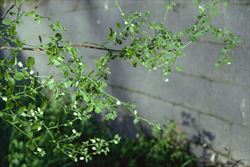
habit (Photo: Trevor James)
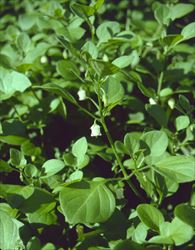
habit (Photo: Trevor James)
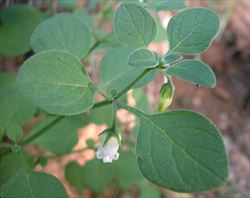
paired leaves, one slightly larger than the other, and drooping flowers (Photo: Greg Jordan)
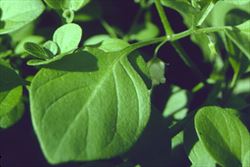
close-up of leaf (Photo: Trevor James)
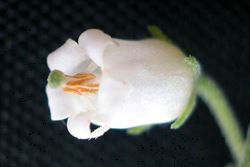
close-up of tubular flower with petal lobes bent backwards (Photo: Greg Jordan)
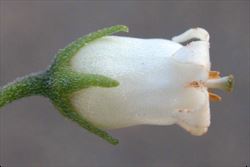
close-up of flower from side-on (Photo: Greg Jordan)
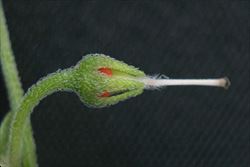
old flower showing ovary, style and stigma (Photo: Greg Jordan)
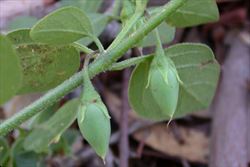
close-up of stems, leaf undersides and young fruit (Photo: Rob and Fiona Richardson)
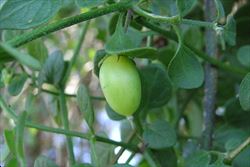
immature fruit (Photo: Ros Shepherd)
Scientific Name
Salpichroa origanifolia (Lam.) Thell.
Synonyms
Atropa rhomboidea Hook.Physalis origanifolia Lam.Salpichroa rhomboidea (Hook.) Miers
Family
Solanaceae
Common Names
cock's eggs, lily of the valley vine, lily-of-the-valley vine, pampas lily of the valley, pampas lily-of-the-valley
Origin
Native to the temperate regions of South America (i.e. southern Brazil, Argentina and Uruguay).
Naturalised Distribution
This species is widespread in the southern parts of the country, but is currently scattered and mostly found near populated or urban areas. It is most common and widespread in western and central Victoria and relatively common in eastern New South Wales and south-eastern South Australia. It is occasionally naturalised in eastern Victoria and other parts of New South Wales, and is also present in Tasmania, south-western Western Australia and south-eastern Queensland. It was also naturalised in the ACT, but has not been recorded there for some time.
Naturalised overseas in Europe (e.g. the UK and Italy), New Zealand, southern and eastern USA (i.e. Virginia, North Carolina, South Carolina, Georgia, Florida, Louisiana, Texas, New Mexico, Arizona and California) and beyond its native range in South America.
Habitat
A weed of gardens, roadsides, urban bushland, waste areas, disturbed sites, fences and coastal environs in temperate, semi-arid and occasionally also sub-tropical environments.
Habit
A creeping (i.e. prostrate) or semi-upright (erect or ascending) herbaceous plant or woody vine with scrambling or trailing stems up to 3 m long.
Distinguishing Features
- a creeping herbaceous plant or woody vine with scrambling or trailing stems produced from a long-lived woody rootstock.
- its small leaves may be borne in pairs or alternately arranged along the stems.
- leaves that are borne in pairs are of unequal size, with the smaller ones being about three-quarters the size of the larger ones.
- its small white or cream-coloured tubular flowers (6-10 mm long) have five spreading petal lobes and are borne singly, or sometimes in pairs.
- its fruit is a smooth yellow or whitish-coloured berry (10-20 mm long).
Stems and Leaves
Its numerous stems are produced from a long-lived (i.e. perennial) woody rootstock. These stems are upright (i.e. erect) at first, but become creeping (i.e. prostrate) or scrambling as they lengthen. Younger stems are rounded, sparsely to densely hairy (i.e. pubescent) and green in colour, while older stems become four-angled in cross-section (i.e. quadrangular).
The simple leaves (5-50 mm long and 5-35 mm wide) may be borne in pairs or alternately arranged at the stem joints (i.e. nodes). They are egg-shaped in outline (i.e. ovate) or oval (i.e. elliptic) in shape and borne on stalks (i.e. petioles) 5-25 mm long. These leaves are finely hairy (i.e. puberulent) and have entire margins. Leaves that are borne in pairs are of unequal size, with the smaller one being about three-quarters the size of the larger one.
Flowers and Fruit
The white or cream-coloured flowers (6-10 mm long) are tubular with five curved (i.e. reflexed) petal lobes. They are borne singly, or sometimes in pairs, on stalks (i.e. peduncles) 7-10 mm long that emerge from the upper leaf forks (i.e. axils). These flowers generally have a drooping or nodding appearance. Flowering occurs throughout the year, but is most common during summer.
The fruit is an elongated or egg-shaped (i.e. ovoid) berry with a smooth surface texture. These berries (10-20 mm long and 7-8 mm wide) turn yellow or whitish in colour as they mature and each contains several seeds. The seeds are brown to pale yellow in colour, flattened, rounded in shape (about 2 mm across), and surrounded in a sticky substance.
Reproduction and Dispersal
This species reproduces by seeds and vegetatively from creeping underground stems (i.e. rhizomes) and suckering roots.
Root fragments and pieces of underground stems (i.e. rhizomes) are spread during soil moving activities and in dumped garden waste. Seeds are dispersed by similar activities as well as by animals that eat the fruit (e.g. birds, rats, mice and ants).
Environmental Impact
Pampas lily-of-the-valley (Salpichroa origanifolia) is regarded as an environmental weed in New South Wales and Victoria, and as a potential environmental weed in Tasmania. It ws recently listed as a priority environmental weed in at least one Natural Resource Management region.
Legislation
This species is declared under legislation in the following states and territories:
- Tasmania: D - the importation or sale of this species is prohibited and measures to reduce its population in an area, eradicate it from an area, or restrict it to a particular area may be required.
- Victoria: C3 - all reasonable steps must be taken to control the weed and prevent its spread (in the Glenelg, Goulburn and West Gippsland regions).
- Western Australia: Unassessed - this species is declared in other states or territories and is prohibited until assessed via a weed risk assessment (throughout the entire state).
Management
For information on the management of this species see the following resources:
- the Randwick City Council environmental weeds profile on this species, which is available online at http://www.randwick.nsw.gov.au.
Similar Species
Pampas lily-of-the-valley (Salpichroa origanifolia) has flowers that are very similar to lily-of-the-valley (Convallaria magalis). However, lily-of-the-valley (Convallaria magalis) does not have creeping stems, has larger leaves that sheath the stems, bears several flowers on each flower stalk, and has berries that turn red when they mature.

